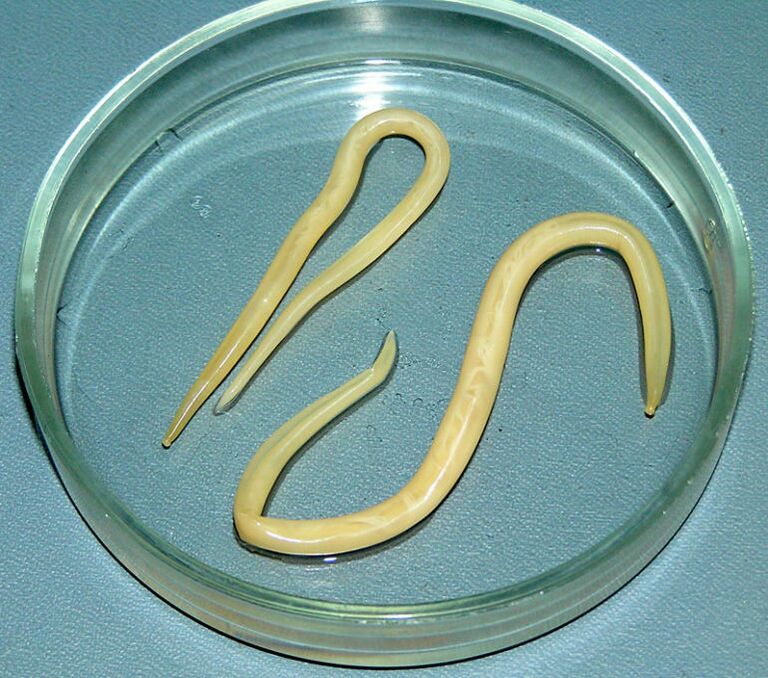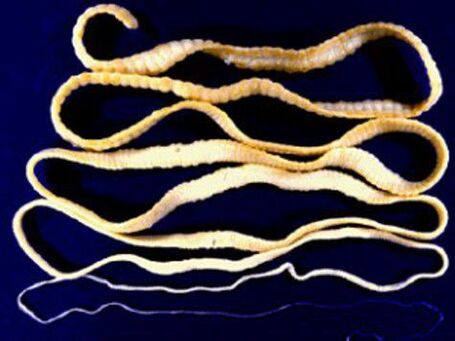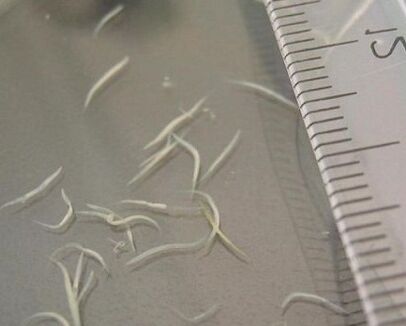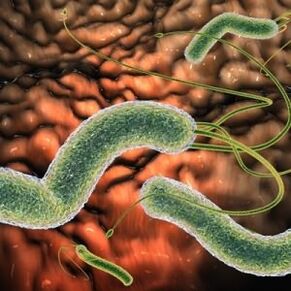Studies in the field of parasitic medicine are reported by alarming facts. More than 90% of all categories of population ages are affected by helminthic occupation, or have a hidden form of transport of different parasites. They cause many problems, causing various diseases that prevent a person's normal life. Habitat choice - the human body, parasites can spread virtually in all organs and systems, causing pathological changes in them and violating the function of their work.

The main types of parasites in the human body
The group of parasites that make their human body habitat include the simplest microorganisms, round worms and tape:
speaker. These are small parasites (long, no more than one and a half cm), which are transmitted in the interior, or in contact with an infected person. Very often, the flies that hold the larvae of these parasitic worms are for the carriers of this helminthic occupation. Once in the products, they stay there for a long time, and if they are not processed, then they enter the human body. Spread in the human body, they cause enterobiasis. Most often, preschool and school children undergo this type of disease. Enterobiasis lesions in children and the adult population can reach up to 90 percent. The habitat of these parasites is the segments of the blind, the intestinal coloner. This type of parasites does not breathe in the air; Oxygen is not required for its existence. Nutrients for him are intestinal contents. After mating, which occurs in the ileum ileum, dragging from the anus, the female lays the larvae in the anus sphincter area. The greatest risk that enterobiasis is very contagious. Parasites are very easy to infect with the slightest deviation from individual hygiene norms.
Ascarids. Belong to the class of round worms. Parasitized in the small intestine. Call ascariasis. The source of infection is a sick person or animal. Infection occurs through food, not wash hands. Cysts of parasitic worms, which fall to the ground, mature at larvae levels, they are dangerous to humans. If a person has previously used unwashed fruits or vegetables, the body is infected. This is also facilitated by non -sanitary conditions of the settlement, insufficient treatment of food heat.
Ankylostoma. They lead to the development of the pathological process in the body. This is a small parasite, which reaches no more than 2 cm in its length. Most often, young children are infected (especially in rural areas, due to barefoot).

Tape. It belongs to the band of stripe worms, there are 12 types. The main site of parasitization is the intestinal department. The main route of body infection occurs when the fish (which did not pass sufficient heat treatment), or through objects used to cut the meat (knives, cutting board). This type of parasites feeds on all the beneficial substances a person uses. Its length can reach 15 meters.
damage. These are tape worms, the length of which is 10 meters. When infected with the bull cork spores, tusarinchosis develops, and in the case of pork chain larvae, taeniasis disease develops, its phase of larvae is called cystiracosis. The development of such pathologies is most often facilitated by eating, poorly processed meat. But sometimes infection can occur through unwashed hands and food. As a rule, in the small intestine of the body, when infected with this disease, a stripe worm lives. In some cases, the duration of its existence may take up to 20 years. Since, with the help of its hooks, which are in the parasitic head, it is tightly attached to the wall of the small intestine. And for this reason, sometimes difficulties arise for its attraction.
echo. These are tape worms up to 8 mm long, they can cause a disease called echinococcosis. The disease is often found in animals (cats, dogs, foxes, wolves). It should be noted that the human body, for echinococcal pathology, is an intermediate place of residence. The process of infection occurs during direct contact with the animal, or when cutting it. This type of disease is more affected by the rural population engaged in livestock. The disease very often occurs without symptoms, and in the case of their appearance, cystic formations occur. To remove them, it is only necessary to use the surgical method.
Lamp. Lead to the development of lambliosis. The parasites belong to the Hakutikov class, they are representatives of the demolomonadid's secession. A favorite habitat is a small intestine of a person or animal. Sometimes they can affect the digestive system of birds. The infection occurs in two ways: sometimes there is infection through the respiratory tract. The cysts enter the body through the lungs, along with suction powder, clinical photography in this pathology can be disguised as other diseases. And it is associated with the development of diseases of the nervous system, heart, endocrine.
Parasitic. They are able to cause various pathological conditions in the human body (actinomycosis, liqueur, microsporia, tricophitosis, favus, erytrazm). They live in the human body, touching the skin, hair, nail phalanxes.
Parasites of African malaria. This group includes malarial plasmodians. They are able to cause malaria. This disease is transmitted only through mosquitoes. For our area, this disease is not characteristic. It is subject to people living in the southern countries. Such an infectious disease can develop when visiting these countries. One feature of this disease is that residents of the area have the opportunity to become much lower than tourists. This is due to the fact that they develop immunity.

The infection is based on several basic ways:
Fecal-oral. Use of unwashed vegetables and fruits, not boiled water.
Enraged. With this type of infection, the larvae of helminthic occupation fall through the pores of the skin.
Contact house, through daily household items, or in contact with the infected.
One feature of all forms of helminthic parasites is that they eat at the expense of their owner (person or animal) while he chooses useful nutrients (glucose, micro and useful, carbohydrate). As a result of such a pathological effect, the body begins to experience an acute deficiency of potassium, magnesium, zinc, silicon, selenium, and many vitamins. Another feature of these parasites is a high degree of adaptation. They adapt to the working conditions of the owner's body. And they have become invisible to the immune system.
Causes of infection with human body parasites
Among the ways of infection, the following can be distinguished:

Eggs and parasite larvae penetrate the body when using polluted, immature water. Or when eating food (fish, meat, canned food), which have not received sufficient heat treatment. This is also facilitated by eating unwashed vegetables and fruits.
Eggs and helminth cysts remain on the surface of the skin with direct contact with daily objects (door gloves, money, toys, stairs). Moreover, the source of the infection can be contained in the soil when contacting the soil, the spores of the parasites fall into the hands. And if they are not completely washed, then this also creates a risk of threatening the body's infection with different types of helmets. Therefore, the hands should be washed not only before you eat, but several times a day, especially if there are contacts with the land.
Various insects (flies, waters, fleas) create a real threat of infection with worms. For this, the insect does not have to make a bite. It is enough for them, sometimes to penetrate freely into the apartment, and sit on food, cutlery, leaving in them the spores of parasitic worms.
If daily work consists of direct contact with animals (veterinarian, rural resident, livestock), the probability of the disease increases significantly.
The main signs and symptoms of parasites in the body
A very important role in the emergence of first signs and underlying symptoms with the development of helminthic invasions is occupied by their location and abilities in the human body. Most often, they are placed in the upper parts of the small intestine (wide tape, bull and pig chain, ascarides).

Vlasov, to his habitat, chooses the large intestinal segment. Opistorchosis affects the canal biliary tract. Pin worms are located in the colon and rectum lumen. Serious dangerous diseases can occur:
Pain during urination.
Adenomatous growths.
An irregular, painful menstrual cycle.
The emergence of hepatitis and dermatitis.
It is very important to pay attention to the above symptoms. Despite the fact that, at first glance, they seem harmless, in fact, such signs may indicate the presence of parasites in the body.
Symptoms that occur when parasitizing the body are often perceived by patients as the presence of any other disease that is not associated with the appearance of worms. This is a great difficulty in making an accurate diagnosis. The main symptoms in the development of parasitic worms in humans:
Violation of the act of defecation (constipation). It seems due to the fact that the accumulation of worms makes it difficult to pass the feces into the intestinal lumen.
 Sometimes diarrhea is observed. This is due to the enlarged production of ferminas (substance similar to hormones, produced in the body of parasites), and leads to an imbalance of chloride ions. What explains the cause of diarrhea.
Increased gas formation.
There is a violation of the processing and assimilation of the lanoline (fat). This is due to the fact that from parasites to the lumen of the small intestine, parasites cause inflammatory disease of the intestinal mucosa.
Arthralgia and muscle pain occur.
In response to the body, manifestations of allergies appear, sometimes in the form of urticaria.
Probably the development of ulcerative eczema, dermatitis of the skin, the appearance of tumors.
In the case of the development of helminthiasis, which feeds on blood elements, anemia of iron deficiency is possible.
With a clinical blood examination, a small amount of red blood cells is marked, a decreased level of hemoglobin, and a decrease in color indicator.
Very often, granulomas of the abdominal cavity or uterus, in the lungs and liver.
The patient's psycho -emotional state is impaired, which is expressed by aggressive unreasonable conditions, increased irritability.
Due to the severe itching in the anus, the night's sleep is worried.
At night, the patient has a tooth noise (bruxism).
Lack of choline, vitamins, amino acids, proteins and carbohydrates leads to the development of chronic fatigue, a division of forces.
Constant feeling of hunger, developing anorexia symptoms.
Heart muscle disease, heartbeat failure.
In severe cases, the development of oncopathology.
Sometimes diarrhea is observed. This is due to the enlarged production of ferminas (substance similar to hormones, produced in the body of parasites), and leads to an imbalance of chloride ions. What explains the cause of diarrhea.
Increased gas formation.
There is a violation of the processing and assimilation of the lanoline (fat). This is due to the fact that from parasites to the lumen of the small intestine, parasites cause inflammatory disease of the intestinal mucosa.
Arthralgia and muscle pain occur.
In response to the body, manifestations of allergies appear, sometimes in the form of urticaria.
Probably the development of ulcerative eczema, dermatitis of the skin, the appearance of tumors.
In the case of the development of helminthiasis, which feeds on blood elements, anemia of iron deficiency is possible.
With a clinical blood examination, a small amount of red blood cells is marked, a decreased level of hemoglobin, and a decrease in color indicator.
Very often, granulomas of the abdominal cavity or uterus, in the lungs and liver.
The patient's psycho -emotional state is impaired, which is expressed by aggressive unreasonable conditions, increased irritability.
Due to the severe itching in the anus, the night's sleep is worried.
At night, the patient has a tooth noise (bruxism).
Lack of choline, vitamins, amino acids, proteins and carbohydrates leads to the development of chronic fatigue, a division of forces.
Constant feeling of hunger, developing anorexia symptoms.
Heart muscle disease, heartbeat failure.
In severe cases, the development of oncopathology.
Not only the type of parasite that is placed in the human body, but also its age, gender, physical characteristics of the body, has a significant impact on clinical appearance.
With the development of the acute phase of damage from helminthic invasions, the patient has all the signs of acute intoxication of the whole organism:

Nausea, turning into unbearable vomiting.
Hyperthermia (sometimes in high numbers 38. 9).
Anorer's skin rashes.
Regional lymph nodes are inflamed.
Pathological processes in the liver and lung deteriorate.
If such symptoms appear, visits to the doctor is essential
Diagnosis of parasites in the human body
For an accurate diagnosis, you should consult a parasitologist. But often in the city clinics there is no such standard unit. Therefore, you should contact a therapist or gastroenterologist for later tests and further consultation of a parasitar of infectious disease. For a long time, determination of infection with parasites was performed only by performing fecal tests for the presence of worm eggs, or duodenal sound. A fence of intestinal content material was performed.
Introducing a probe. Such research methods do not always reveal the presence of worms in the human body. Modern diagnostic methods (ELISA tests) allow you to detect and determine any form of parasitic worms in the human body. They are based on the identification of antibodies that the body produces in response to intoxication caused by helminthic occupation. Moreover, serological techniques were widely used:

As an additional research method, it is used:
Endoscopic examination.
Ultrasound.
MRI
Endobiopsy.
Establishing an accurate diagnosis using PCR.
Relatively recently, a system-syntrome system has emerged. It is able to detect endotoxins, microbial flora and tumor cells using an enlarged electromagnetic range. With the help of frequency resonance therapy, you can not only diagnose, but also effective therapy of any form of helminths results, no matter where they live.














































